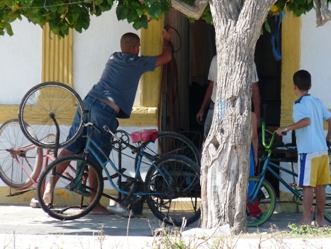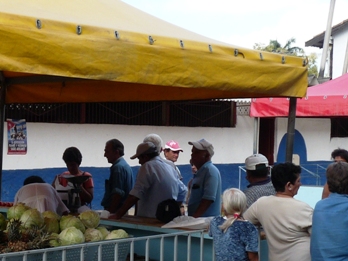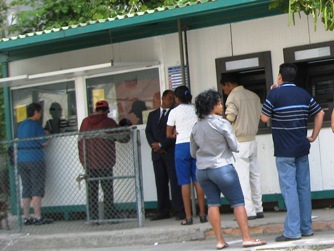Trinidad, Cuba. This year's destination?
Cuban Tips and Tricks
Cycling in Cuba is great with little traffic and nice weather.† Even so it is one of the more challenging of the countries in which we have cycled.† Meeting and overcoming these challenges of all kinds is part of the enjoyment to be gained from cycle touring.† This page was written on the day we left Cuba.† It gives some of the information we would have liked before we started but could not find in the published guides.† Please contact us if you would like more information.

|
Poncheros mend local bikes |
Health and Safety for Travellers in Cuba
Cuba is not a third world country but we treated it as such:
- We only drank bottled water and lots of it.
- We did not swim in fresh water swimming pools or in the sea near to habitation.† We saw no water or sewage treatment plants.† We also saw no rubbish or soiled toilet paper treatment plants.† Raw sewage is in the streets and sea.
- If it smelt or looked nasty or dangerous we accepted that it was and kept well away from it.
- We only ate food which we could see was clean and properly cooked through.
- Risk of theft, mugging or attack was similar to the UK and we took similar precautions.
- We avoided crumbling balconies, buildings, roads and paths.† We watched for the often missing or unsafe manhole covers, big holes and cables in the street which may be live.†
- Had we needed medical care we would have found our way to a tourist hotspot, for example Varadero.† A third world medical kit would be worth taking unless you believe Fidelís claims.
- The mozzies at the time we went were nothing like as bad as we were led to expect.† Getting bitten now and again is unavoidable unless you use Deet.† We found no need, in casa particulars, to use mosquito nets.† We used Avonís ďSkin so SoftĒ which contains citronella.† Had we been concerned at getting the occasional bite and were prepared to take the risk we may have used Deet as well in the wet areas.
 |
Markets and street food sellers are always paid in pesos |
Our day to day tips for cycle tourists in the dry season, December to March
- The climate feels lovely but is harsh.† Until fully acclimatized be at your destination by noon.† In a few places, not many, pollution is bad and it gets worse as the day heats up.† If you stay in casa particulars they will give you breakfast from 6am onwards without complaint.† It is also very nice in Cuba early in the morning.
- For clothing you only need what you ride your bike in on a very warm summer day in the UK, plus one change of these clothes if you must.† You will also want toilet stuff, map, tools and a spare tube.† Anything else you take you wonít need but you may like to have.† Our snorkel stuff was indispensable but we did not open our front panniers for days on end or use waterproofs.
- The only stretch of road we found where cycling is banned was the Havana tunnel Ė use the ferry or bike bus.† Cuban traffic is slow, considerate and safe.† There are occasional smooth roads but most are very bumpy at best.† The safest way to enjoy it is to treat all cycling as you would an off road ride on tracks and use a suitable bike.† The terrain varies between being as flat as Holland to serious mountains. †In country areas on minor roads you can go for an hour without seeing a motor vehicle but there are always people about.
- Cuba has many one way streets and the very occasional traffic lights and roundabouts.† Local cyclists obey the one way signs and stop at traffic lights.† Rules at roundabouts are unclear but there is so little traffic this does not matter much.
- We borrowed a copy of Lonely Planet Cycling Cuba which is dated 2002 and out of print.† Because of its age it is not recommended. We saw European and Canadian cyclists with more modern cycle guides.
- A bike breakdown requiring modern spares will be a problem.† We saw no parts, not even good tyres, available for a modern bicycle.† Poncheros mend local bikes with great ingenuity and have things like sprockets, spokes and pedals, some of which may be second hand.† If you canít repair your bike reasonable quality bikes can be hired from some of the main centres.† To our knowledge only very low quality mountain bikes can be bought in Cuba.† These are in the larger dollar shops for about 130 CUCs.† Also see below.
- With Cuban dollars in your pocket you are thought of as fabulously rich by most Cubans and they will know you are a tourist.† The ordinary Cuban people were very nice to us and did not rip us off.† As a cycle tourist the advantage of this wealth is that in an emergency it should be possible to buy your way out of almost any problem.† Just wave someone down, they are naturally helpful even without the financial incentive.† In the tourist centres almost exactly the opposite applies.† The state has devised ways of extracting dollars from you in any number of ways.† The best way to avoid this is to spend as little time in Havana and other centres as possible.
- There is almost no convenience food, fruit or even chocolate bars sold in the shops.† Street food, for us pizzas, bought freshly cooked with pesos was our mid ride snack.
- We stayed in casa particulars.† They will properly home cook a substantial dinner and breakfast and provide packed lunch.† Given notice they will cook anything you ask them to.† They usually have two ensuite rooms which are always air conditioned.† Once in the loop they will almost always want to book the next place for you.† A couple half board will usually pay around 50 Cuban dollars a night, singles about 40.
- Camping facilities and self catering do not seem to exist.
- You may have to use hotels or campismos where casa particulars are not available on the route you are doing.† †Hotels and campismos are usually very scruffy and seldom have hot water.† The food they mutilate is probably imported frozen from Canada.† It may have been refrozen several times since then.†† Hygiene standards and the ability to cook food through properly seem poor.† The portions are too small to support cycle touring and could cause food poisoning.† You could also pay twice the price of a casa particular.
- Donít give anything to beggars.† No one in Cuba is starving (except cyclists staying in hotels) or without housing, clothing, shoes, health and education.
- Hustlers can be a nuisance particularly after a long hot ride. Almost anyone who approaches you in the street is one.† Usually we would say no politely twice and then ignore them.† They can offer a bit of harmless fun by asking them for some impossible requirement or pretending not to speak English or Spanish.† We would always try to talk to anyone who was friendly or curious and not hustling.
- The dual currency of pesos and Cuban dollars called CUCs is difficult to understand but you soon learn which shops accept which.† Street food and markets are always in pesos and super cheap to us. You can change dollars to pesos at signed Cadecas and are unlikely to need to change more than 5 dollars at a time.† Shops only accept one or the other and some pesos shops will not sell to tourists.†
- We tipped as we would in the UK and didnít give away clothing or equipment.† The alternative would make the beggar and hustler problem worse and encourage children to take part.† You will hear claims that people only get the peso equivalent of 12CUCs a month.† The claims may be true but they do little or nothing for it and get huge subsidies on almost everything.† There are also opportunities for Cubans to earn CUCs.†
- Mobile phones work in many more places than we expected but there is often no coverage in outlying places.† The system will handle texts (sms) but not data calls.† Casa particulars will almost always make Cuban calls for you or let you use the phone.† Peso phone cards are very cheap but public phones are difficult to use, see below.
- For internet, email and phones we used ETECSA.† You buy separate scratch cards for internet and phone.† ETECSA has offices in most medium and large towns.† It is often easy to find them by cycling around town and looking for the largest communication mast.† If they are open there will always be a queue of Cubans at the door.† Just walk past them and go to the, usually empty, counter displaying headsets, phones etc. You will need your passport to buy cards. You can then go to any free internet terminal and follow the instructions.† Internet speed is very slow and patience is needed.† All the machines we used accepted USB input.† Email accounts work but will not open attachments.† The internet is much too slow to Skype. In tourist centres there are other internet places but they were always slower and less convenient than ETECSA.
- Beware some of the information in the usual backpackersí guides for Cuba.† We think tourist numbers and facilities have substantially reduced in recent years and this is not reflected in the guides.† This hardly affects our kind of cycling but many of the facilities referred to do not exist or are much reduced.† The accommodation lists in the guides are still just about worth looking at.† Unless you are going anyway phone before you ride to make sure what you want is still there.
- In most places standard capitalist rules donít work.† Prices are almost always the same so there is no point in shopping around.† This would make life easy for cyclists except that the service levels are appalling.† Even if there is no one waiting you will often have to ask for service.† Most requests, particularly in state run places, are met with a blank stare as are complaints which are pointless.
- It will take a very long time to do anything official including going to banks.† It is best to do these things as infrequently as possible.† Try to make sure the organisation you are at can deliver what you want before joining the inevitable queue.† Queues start outside the doors with a door person letting in a few at a time.† Staff may well go through a lengthy procedure with you when they know full well they donít have what you want in the first place.† Try to find out what the procedure is and insist on it being followed to the letter without letting manana set in.† We never resorted to presents or bribes but donít discount this.† You may be able to obviate all this by joining the Cuban Communist Party but we were unable to establish the correct procedure.

|
The stoker changing Cuban dollars to pesos at a Cadeca |
Home
Cuban tips + tricks
Route and Navigation
Voyage Out 1
Voyage Out 2
Week 1
Week 2
Week 3
Week 4
Week 5
Return Voyage 1
Return Voyage 2
Cargo Ship Travel
Stoker's Leg
Bike and Gear
Transporting Bikes
Photos
Links and Downloads